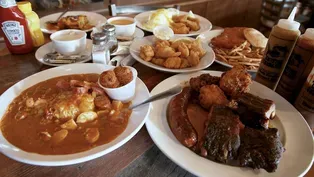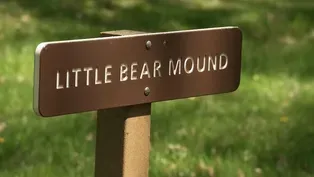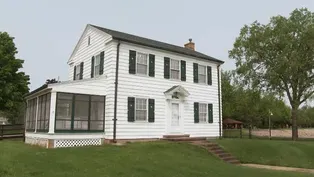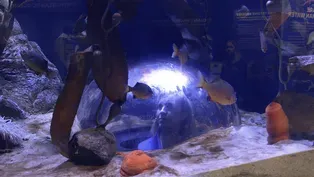
Great River Road National Scenic Byway - North
Season 1 Episode 104 | 26m 45sVideo has Closed Captions
Visit treasures along the Great River Road National Scenic Byway from Lansing to Dubuque.
Explore the beauty of Iowa's driftless region with a drive along the Great River Road National Scenic Byway. Tour monuments and parks around Lansing, and explore art, history and an iconic eatery in Iowa's oldest city, Dubuque.
Problems with Closed Captions? Closed Captioning Feedback
Problems with Closed Captions? Closed Captioning Feedback
Road Trip Iowa is a local public television program presented by Iowa PBS

Great River Road National Scenic Byway - North
Season 1 Episode 104 | 26m 45sVideo has Closed Captions
Explore the beauty of Iowa's driftless region with a drive along the Great River Road National Scenic Byway. Tour monuments and parks around Lansing, and explore art, history and an iconic eatery in Iowa's oldest city, Dubuque.
Problems with Closed Captions? Closed Captioning Feedback
How to Watch Road Trip Iowa
Road Trip Iowa is available to stream on pbs.org and the free PBS App, available on iPhone, Apple TV, Android TV, Android smartphones, Amazon Fire TV, Amazon Fire Tablet, Roku, Samsung Smart TV, and Vizio.
Providing Support for PBS.org
Learn Moreabout PBS online sponsorshipKohlsdorf: For this episode of "Road Trip Iowa," we're traveling the Great River Road from Lansing to Dubuque.
Is it weird that I'm scared?
Exploring Iowa's most unique terrain in an area known as the Driftless Region.
Next on "Road Trip Iowa."
Woman: Kwik Star is proud to be a part of Iowa communities across the state.
Family owned for over 50 years, we're dedicated to treating our guests, employees, and communities as we would like to be treated.
Man: Musco Lighting is an Iowa company that travels across the U.S. and to more than 125 countries to light community recreation fields, stadiums, airports, monuments, and more.
While our reach is global, we're committed to our local communities.
♪♪ ♪♪ ♪♪ The Great River Road National Scenic Byway follows the Mississippi River 3,000 miles from Minnesota, all the way down to the Gulf of Mexico.
On this episode, we travel Iowa's northern section of this famed route from Lansing to Dubuque.
Let's take a look at our itinerary.
We'll visit a decades-old family-run business based in the Mississippi River.
Stretch our legs touring national monuments and state parks.
We'll tour street art and history in Iowa's oldest city.
And we grab a bite at an iconic eatery.
We begin our trip in the northeast corner of the state, in the Driftless Region, where the limestone bluffs and spring-fed waterfalls form a unique natural landscape.
The northeast corner of Iowa is commonly referred to as the Driftless Region, an area of the Midwest left untouched by glaciers.
This created a unique landscape of breathtaking views filled with beautiful hills, spring-fed waterfalls, cold-water streams, and limestone bluffs.
We are very much unique to not only Iowa, but to other parts of the world, as well.
The Driftless Area is made up of parts of four states -- northeast Iowa, southeast Minnesota, southwest Wisconsin, and northwest Illinois.
It's about 24,000 square miles total.
But, you know, in the scheme of things, that's a pretty small area.
Kohlsdorf: To learn more about how this region came to be, we stop at the Driftless Area Education & Visitors Center, situated just south of Lansing.
You know, we knew going into the building of this center that there's no way we could cover everything there is to see in the Driftless Area.
So we just wanted to give people a 30-second snippet of everything from the Mississippi River to the cold-water streams to the effigies, like at Effigy Mounds National Monument, to, you know, everything that they could imagine when they're in this small ecosystem of the Driftless Area.
Kohlsdorf: Opened in August of 2017, the nationally recognized interpretive museum has a front-row seat on the Mississippi River.
The center provides educational opportunities for travelers to explore the science, history, and culture of the Driftless Region along the Great River Road.
♪♪ ♪♪ ♪♪ The history and culture of river life is on full display at the Driftless Area Education & Visitors Center.
Further down the Great River Road, near Harpers Ferry, we stop in to visit a family that has harvested their way of life from the mighty Mississippi River for generations.
Mohn: Well, we opened the market in 1982.
On my side of family, it goes back as far as I know, back to my great-grandparents.
And that was just the way they all made their living was in the fishing.
And my dad and mom had the market right across the river until they got too old and retired and closed up.
It's closed now, too.
My husband wanted to fish, and he needed a place to sell his fish, so he sold them to my dad.
So, it was either start our own market or go out of the fishing business.
And my husband could never do that.
So, we built a market, and it's grown since then quite a bit.
Kohlsdorf: In catfish alone, Mohn's processes around 4,000 to 5,000 pounds per week.
In the morning, the fish will come in from the river in tanks.
Then we'll start processing.
We'll either just whole-dress or fillet.
And the fish get packaged into boxes.
And then once a week they get delivered to Minneapolis to Asian stores.
We cut them on a Thursday usually or Friday.
Cut him into these chunks with a saw, then put them in the cooler until Sunday.
I put them on to brine in a salt brine overnight in the cooler, and then in the morning we put them on these, wash them again, put them on these trays, and put them in the smoker.
Catfish, carp, sturgeon, and bullheads.
Kohlsdorf: Stationed right on the Great River Road, Mohn's Fish Market is carrying forward generations of tradition and a way of river life from days gone by.
Jones: Almost everybody back then, you either farmed or you fished.
And they used to put them all on railcars to be taken to Chicago or New York.
But there isn't the market there used to be for them now.
We do get a lot for the smoked, the walk-in for the smoked.
People seem to think it's an experience.
I mean, they come a long ways for it.
♪♪ Kohlsdorf: If the saying is true and a single picture truly is worth a thousand words, then scenic views along the Great River Road must contain volumes of stories about the history, geology, and culture of Northeast Iowa.
Just outside Harpers Ferry, Effigy Mounds National Monument displays some of the region's oldest human history.
Twenty different regional tribes are credited with building the Effigy Mounds, which date back at least 1,000 years before French and Canadian traders settled in the area.
Park trails guide visitors past 206 prehistoric mounds, or effigies, shaped to represent animals such as bears and birds.
Some served as burial grounds, while others may have been created for ceremonial purposes to mark sacred ground.
Managed by the National Park Service, Effigy Mounds National Monument encompasses Clayton, Dubuque, and Allamakee County.
The ceremonial markers can be found throughout the upper Mississippi River Valley, stretching through Wisconsin.
Minnesota, Iowa and Illinois.
[ Birds chirping ] Further down the Great River Road, near the town of McGregor, rests another must-stop site for Northeast Iowa travelers.
Spanning nearly 1,000 acres, Pikes Peak State Park features 500-foot views overlooking the confluence of the Wisconsin and Mississippi rivers.
Opened in 1935, the park is named for the same explorer whose name also rests upon one of the tallest peaks along the Rocky Mountains.
Pikes Peak welcomes travelers with 11 miles of hiking opportunities.
One signature stop for nature lovers is the Bridal Veils Fall Trail, a half-mile boardwalk to one of the park's most popular places.
Views along the trails in Pikes Peak State Park reveal the region's rich history, with over 60 effigy mounds dating back more than 1,000 years.
Taken together, Pikes Peak and Effigy Mounds offer road-trippers an opportunity to stretch their legs and take in some of the best views in the Hawkeye State.
Commercial navigation along the Mississippi River is made possible by a system of locks and dams.
The Lockmaster's House Heritage Museum in Guttenberg offers a look back at this vital industry and a shoreline view of where it stands today.
Many towns along the Mississippi River are working models of history.
Guttenberg showcases some of its history at lock and dam number 10.
Grieve: We're at the Lockmaster's House Heritage Museum, run by the Guttenberg Heritage Society.
It was founded in 1991 as a museum to preserve the history of the river and the town.
Kohlsdorf: River towns with a lock-and-dam system were crucial for the development of the country.
The U.S. Army Corps of Engineers is the government agency charged with operating the lock-and-dam system.
From 1938 to 1973, the Army Corps required a close, hands-on approach for the operation of the locks.
Kohlsdorf: One rule lockmasters had to live by was where they lived.
The Army Corps of Engineers mandated lockmasters must live on site of the lock and dam in their care.
Grieve: In 1972 they lifted that requirement for them to live on site.
Kohlsdorf: The Lockmaster's House Museum showcases construction of lock and dam number 10, along with exhibits displaying some of Guttenberg's rich past.
The Working lock and dam offers travelers just one example of how the Mississippi River weaves history through the communities along its banks.
They come up the Great River Road.
They stop, see our 3-mile-long park here in town, and then wander down here to see the lock and dam, and then they usually come in here to see what this is all about.
Kohlsdorf: Completed in 1937, lock and dam number 10 at Guttenberg is part of the Upper Mississippi River's 13 lock-and-dam systems, known as the St. Paul District.
In 1969, the Army Corps of Engineers refurbished the lock and dam, and the system is still in use today.
The Great River Road leads to Iowas first city, Dubuque.
Perched on the bluffs of the Mississippi, this town offers plently of culture for travelers to explore.
We begin downtown, where past and present meet on the street.
Were proud of our art, proud of our town and people come here and Its certainly a discovery That needs to be viewed on the Mississippi and the Great River Road.
♪♪ In 2016, we did our first murals.
It started out right in the middle of downtown Dubuque, in historic downtown Dubuque.
I think we've got about 60 murals in Dubuque.
♪♪ You know, there was a variety of artists ♪♪ that brought their own interpretation.
Through the process, we would identify a wall, talk to the landowner, and then send a picture of that to people that we thought in the art world that would do botanical work or historic work, whatever, and kind of get a fit for this wall and have them submit their ideas for the wall.
♪♪ We run the gamut.
Some of them are playful.
Some of them are a little more serious.
Some of them might have a nod to the building they're on, ♪♪ and each one of them has a story.
♪♪ We want people to be able to walk down the street and look at these pieces of art and feel uplifted, feel noticed and feel recognized and feel like they mean something in this world.
I think that's one of the greatest aspects of it.
♪♪ At the western end of Fourth Street in downtown Dubuque, River Road travelers can experience a piece of the city's living history woven into the scenic bluffs.
♪♪ The Fenelon Place elevator has been around since 1882, when owner-operator J.K. Graves, a banker and city official, wanted a speedier route to the office from his home atop the bluff.
♪♪ Graves' regular horse-and-buggy commute took him 30 minutes to travel to downtown Dubuque, so he petitioned the city for permission to build a railcar system, inspired by those he had seen in Europe.
The elevator is a cable-car system using two cars.
One car's weight counterbalances the other as they travel up and down the bluff.
An A.C. motor at the top of the hill controls the start and stop of the cars.
♪♪ Placed on the National Historic Registry in 1978, ♪♪ the elevator today is owned and operated ♪♪ by the city of Dubuque.
For a minimal fee, travelers can ascend to the top of the bluff and take in the breathtaking views of Iowa's oldest city.
Dubuque is home to the National Mississippi River Museum and Aquarium.
More than 150,000 people visit each year to learn how the mighty Mississippi shapes the Midwest.
Let's take a look inside.
♪♪ We are here with Emily Adlfinger here at the River Museum.
This is a great backdrop.
Tell us where we are.
Yeah.
So right now we are in our Rivers to the Sea exhibit in the National River Center.
And this is our Gulf of Mexico aquarium.
It's 15 feet deep and 45,000 gallons of water.
And as you can see, lots of fish behind us, as well.
And this museum is really kind of cut up into two separate, smaller museums that have different purposes, right?
Adlfinger: In the other building is our freshwater building.
That tells the history of the Mississippi River.
That's where you'll see our North American river otters, the alligator.
You'll see more of that history side.
Over in this building, we kind of focus on the saltwater life and kind of that connection that the Mississippi has beyond Iowa and just the Mississippi River that we see here.
So, this talks about our species down in the Gulf of Mexico, the Gulf of California.
So, it really tells a broader story.
And both buildings work together to connect that story.
Okay.
What would we see over here?
Yes.
Because there's a lot.
Adlfinger: So, in our Rivers to the Sea exhibit, which is one of our newest renovated exhibits, we have the lionfish, we have seahorses, corals.
You can do a tide-pool touch tank and touch sea stars and sea anemones.
There's so much to explore here.
And it's animals and sea life that you wouldn't normally see when you come to Iowa.
People from really all over have gotten to experience this, and it's something really special for Dubuque and the tri-state area.
I see a lot of people having fun, a lot of kids exploring here.
But you also have a message, a mission, right?
Yes.
At the museum.
So our mission is to inspire stewardship through educational experiences where history and rivers come alive.
And that's really that experience that we're trying to sell when you come to the River Museum.
You can experience the history side.
You know, you can take hours and read all the signs and all the exhibits here to learn something new.
But everything does come alive.
You have the ability to touch in different aspects.
You can get on a boat out in the harbor.
That's one of the really cool aspects that we have here, too.
So, there's a way that you can connect with history and really experience it in a new way.
♪♪ We're here with Maia at the Stingray Touch Tank.
I am really excited to hear about this because it's kind of unexpected to find stingrays in Iowa, right?
Absolutely.
Yes.
This is our Delta exhibit, which is home to our cow-nose stingrays.
So, that's these guys that are here in front of us.
They are considered more of a social animal.
They do hang out in groups.
They do come up to people to kind of interact and explore what is going on as people are reaching in and touching them.
Okay, so tell us a little more about the stingray.
So, this is the cow-nose stingray.
They are found in the Gulf of Mexico area and then up along the Atlantic coast.
One of the things is that we are trying to focus on connections and connecting people to the oceans in different areas.
So, people who are here in Dubuque, if you look outside, you see the beautiful Mississippi River.
That river leads down to the Gulf of Mexico.
So, things that are happening up here in Dubuque are impacting these adorable cow-nose stingrays down in the Gulf of Mexico.
Well, I'm excited.
So we get to feed and pet the stingray.
Is that right?
Absolutely.
Okay, so should we start?
Show me... You rinsed off your hands.
So, what you'll do is just put your hand in there just with two fingers, and then you can touch them as they come up to you.
Okay.
So, the stingrays do have a choice.
If they're not interested, they won't come up to you.
But usually they seem a little bit interested in what's going on here and what we're doing.
So they're pretty social.
Okay.
Is it weird that I'm scared?
No.
Absolutely not.
So, you just kind of touch them back.
So, here's one right there.
Oh.
Hi!
Oh, wow.
And they really do kind of let you have access to them.
Yeah, absolutely.
That's really cool.
Okay, so next we get to feed them.
Is that right?
Okay.
How does this work?
So, I will give you a cup of food.
Okay, this is the real deal.
And what you're going to do is just put it in between your two fingers like this and put your hand flat against the surface, and they will actually come up and suck it right off.
So if you just hold it flat, go all the way down, they'll come up and they'll suck it off.
Okay.
Here you go.
[ Both laugh ] So, you don't have to worry about getting bit because they are going to suck it in first.
What they're going to be eating is stuff that's on the bottom.
Their mouth is on the bottom.
That indicates where they're getting their food from.
Here we go!
Oh, I see someone coming.
Ah!
Okay, I think I got it.
That was perfect.
Okay.
♪♪ ♪♪ ♪♪ ♪♪ ♪♪ Perched on Schmitt Island in the Mississippi River, Catfish Charlie's is a great stop for travelers to soak up the views and take a break for a bite to eat.
How are we doing here?
I'll get those.
Well, the people I get to meet is probably the best part of the day.
Kohlsdorf: Opened in 2005, Catfish Charlie's is the brainchild of Charlie Cretsinger and his wife.
Well, enjoy the rest of your day, okay?
The couple wanted to open a restaurant in Dubuque with a menu matching its idyllic location.
Cretsinger: We decided there was maybe a hole for a seafood restaurant, but I didn't want a regular seafood restaurant.
I like local fishes, so we have everything from catfish, obviously, catfish for Catfish Charlie's, catfish, walleye, bluegills.
And then we do have the shrimp and salmon and things like that.
Our menu is very, very wide.
We are located right on the Mississippi River.
So, you can sit here, look out at the river.
[ Printer humming ] [ Sizzling ] ♪♪ Kohlsdorf: Catfish Charlie's has been open for 19 seasons.
For its menu, the operation harvests 9,000 to 15,000 pounds of fish annually from the Mississippi River.
Cretsinger: Yeah, you build a restaurant, and as that restaurant grows, you want to be unique in certain fashions.
So, why not take fish directly out of the river.
We're river to table.
Kohlsdorf: The restaurant also prides itself on introducing travelers to other local businesses.
Cretsinger: We have a general store inside, which we do all local products -- local jams, local candies, local wines, local whiskeys.
Kohlsdorf: Catfish Charlie's has expanded in many different directions since its inception.
Cretsinger: How are we doing today?
Kohlsdorf: Those traveling on the Great River Road can take a break from driving and cruise on the great river itself.
Hey, buddy, are you going to drive the boat today?
Cretsinger: The American Lady -- it's got a capacity of 135 people.
We do a lunch cruise.
We do a happy-hour cruise.
We do a sunset-dinner cruise.
They range anywhere from an hour and a half to two hours long.
Kohlsdorf: Cretsinger celebrates cuisine found anywhere along the Mississippi River.
On weekends, visitors may find unique menu items being smoked on the patio for special occasions.
Cretsinger: Funny to see people's reactions to when they walk out on the deck and there's a whole alligator on a hog roaster cooking.
Dubuque has a lot to offer here.
So, when you come to Dubuque, we have the River Museum, we have the Mines of Spain, we have the tour boats.
We don't care whether you're eating, drinking, talking, having a good time.
All I want you to do is be here and enjoy it.
[ Laughs ] Well, enjoy.
Thanks for coming in.
Appreciate it.
We visited a family fish market.
Enjoyed Iowas landscape hiking along parks and monuments Learned some history about locks and dams.
and visited a riverside restaurant in an historic Iowa town.
We hope you discovered something new on the Great River Road and feel inspired to get out and see it for yourself.
For more on the culture history and landscapes along Iowas scenic byways join us next time for Road Trip Iowa.
♪♪ Woman: Kwik Star is proud to be a part of Iowa communities across the state.
Family owned for over 50 years, we're dedicated to treating our guests, employees, and communities as we would like to be treated.
Man: Musco lighting is an Iowa company that travels across the U.S. and to more than 125 countries to light community recreation fields, stadiums, airports, monuments, and more.
While our reach is global, we're committed to our local communities.
Video has Closed Captions
Discover Catfish Charlie’s river to table experience in Dubuque. (3m 7s)
Driftless Area Education and Visitors Center
Video has Closed Captions
Explore the history of river life at the Driftless Area Education and Visitor’s Center. (2m 9s)
Effigy Mounds National Monument
Video has Closed Captions
Effigy Mounds National Monument displays some of the region's oldest human history. (1m 30s)
Video has Closed Captions
River Road travelers can experience Dubuque’s living history woven into its Scenic Bluffs. (1m 41s)
Lockmaster's House Heritage Museum
Video has Closed Captions
This museum along the Mississippi River is a working model of history. (2m 17s)
Video has Closed Captions
Visit a family that has been harvesting their way of life from the Mississippi River. (2m 36s)
National Mississippi River Museum & Aquarium
Video has Closed Captions
The National Mississippi River Museum & Aquarium showcases the reach of the river. (5m 30s)
Video has Closed Captions
Pikes Peak State Park offers road trippers some of the best views in the Hawkeye State. (1m 14s)
Video has Closed Captions
The Dubuque art murals are a worthy discovery to be viewed on the Great River Road. (1m 56s)
Providing Support for PBS.org
Learn Moreabout PBS online sponsorshipSupport for PBS provided by:
Road Trip Iowa is a local public television program presented by Iowa PBS




















